![[*]](http://sepwww.stanford.edu/latex2html/prev_gr.gif)
ABSTRACTPreviously, we introduced a new partial-migration operator named Azimuth Moveout (AMO), that rotates the azimuth and shifts the offset of 3-D prestack data. The restriction of this operator to the 2-D case defines a new operator for offset-continuation that has many applications on its own. We apply the 2-D AMO on the synthetic Marmousi data set to reduce its size by coherent partial stacking prior to prestack migration. We show that AMO transformation eliminates the dip filtering action of CMP stacking and preserves the complex geology of the model. We derive a time-space formulation of the 2-D AMO by stationary phase approximation to its Fourier domain definition. The expression for the traveltime curve is used for a Kirchhoff-style implementation, with care taken to avoid aliasing. |
Routine seismic processing of multifold seismic data most often involves normal-moveout (NMO) and common-midpoint (CMP) stacking. While this process has proven to be very powerful for enhancing the reflections of particular moveout velocity, it is also known that or dipping reflections and diffractions, which are very important in fault mapping, are attenuated or destroyed by this process. The application of dip-moveout (DMO) correction prior to stacking aims to suppress this dip filtering action and enable both horizontal and dipping reflectors to stack with the same NMO velocity. However, in the presence of strong velocity variations and steep dips, the dip-moveout correction may not be successful in continuing the data all the way to zero offset.
In this paper, we apply a new partial-migration operator for offset continuation of 2-D seismic data. This operator can effectively reduce the size of prestack data and enhance its signal to noise ratio by coherent partial stacking. It overcomes the limitations of DMO to continue far-offset data in presence of strong velocity variations by stacking over limited range of offsets. We applied AMO to the Marmousi data, a challenging case for depth migration. We compared our partial stacks to those obtained by conventional NMO and CMP stacking to show how AMO can coherently stack sections while preserving complex geology.
The derivation of 2-D AMO is similar to that of Azimuth Moveout (AMO) described by Biondi and Chemingui , which rotates the azimuth and shifts the offset of 3-D prestack data. The AMO operator is defined as the cascade of an imaging operator that acts on data with a given offset followed by a forward modeling operator that reconstructs the data at a different offset. We derive the 2-D operator starting from the classic definition of DMO in the frequency-wavenumber domain () and the definition of its inverse (). A stationary phase approximation yields the expression for the traveltime curve of AMO that is used for an integral-type implementation. This Kirchhoff-style formulation enables the operator to handle unevenly sampled data and gives it further applications, such as regularization of data geometry, missing trace interpolation, and correction for uneven coverage.
In the next sections we demonstrate the application of AMO to reduce the size of the Marmousi data by coherent partial stacking at near and far offsets. The size of the data is reduced by an order of magnitude prior to prestack migration. First, we start by defining the AMO integral operator based on the expression for its travel-time curve which we use for a Kirchhoff-style implementation with care taken to avoid aliasing.
TWO-DIMENSIONAL AMO IN THE T-X DOMAIN
DMO and its inverse DMO-1 can be defined in the zero-offset
frequency ![]() and midpoint wavenumber ky as
and midpoint wavenumber ky as
| |
(1) |
| |
(2) |
The AMO operator is given by the cascades of DMO and DMO-1 and can be written as
 |
(3) |
![\begin{eqnarray}
\lefteqn{t_2(y,h_1,h_2,t_1)=} \nonumber \\ & {t}_{1}\frac{\sqrt...
...-y^2][(h_1+h_2)^2-y^2]}}
}{\sqrt{2}h_2} & h_{2}\geq h_{1}\nonumber\end{eqnarray}](img5.gif) |
||
The left top panel in Figure 1 displays the AMO impulse response
at different input times
for an offset continuation of 800m (h2-h1=-400m).
The shape of travel time curves is similar to that of DMO. In this regard
AMO is similar to DMO in the sense that it continues
the data towards near offsets
but not all the way to zero offset.
The dips of the smile increase with depth (i.e., input time).
The amplitudes along the travel-time curve increase as the square root of
time and decay gradually
away from the apex. The impulse response is filtered to a bandwidth of 10-100
Hz and spatial aliasing was taken care of by applying an operator antialising
filter in order to avoid operator undersampling along the
steep sides of the travel-time curve.
The top right panel shows the AMO impulse response for the same amount of offset
continuation as in the left but for h2 > h1, (i.e., h2-h1=+400m)
The travel time curve has opposite curvature and comparable to that of inverse
DMO. Amplitude variations along the travel time curve are similar to those
of the previous example.
The bottom two panels are similar to the ones at the top but computed for
an absolute
offset continuation of 200m only (.i.e., ![]() ).
).
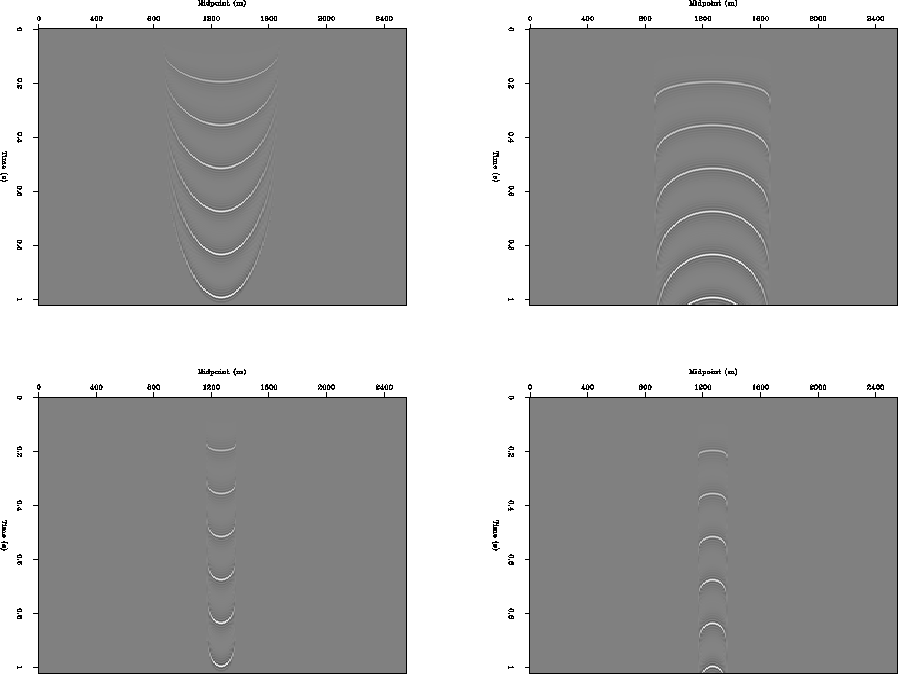 |
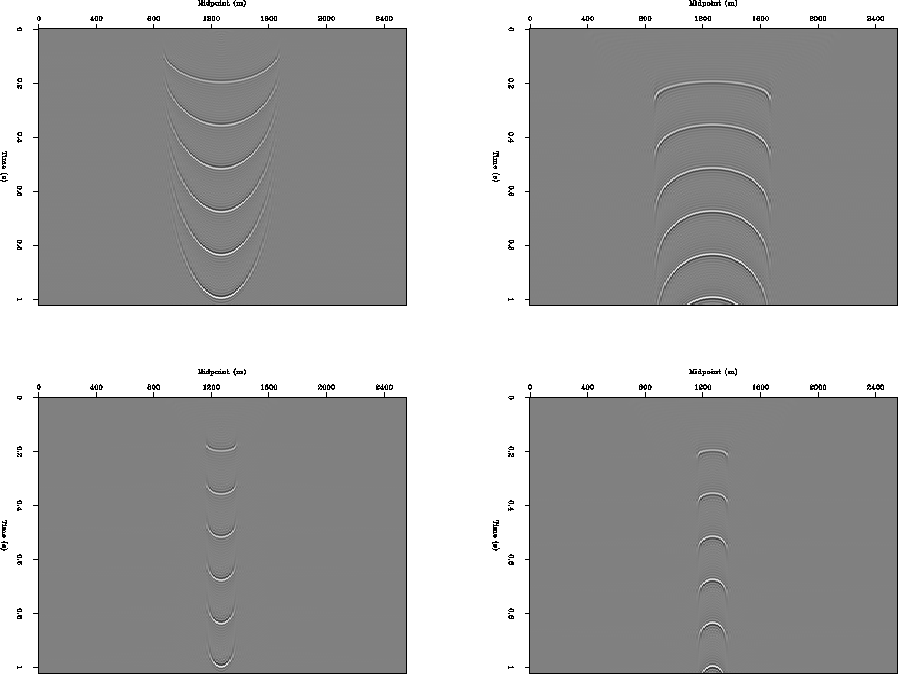 |
As expected, for small offset continuations, the AMO operator is so compact that it does not do much to the data. This is important because the operation is done at an early stage before the velocity is very well known and assumed constant in our derivations. Figure Impulse-fk displays the same impulse responses computed by full implementation of AMO in the Fourier domain using Hale's Jacobian factor. The kinematics of the impulse responses is exactly similar to that derived by the stationary phase approximation. In the next section we illustrate the effects of applying a compact AMO operator on a 2-D prestack data example, the Marmousi model.
COHERENT PARTIAL STACKING OF MARMOUSI DATA
The main application of AMO which is of interest to us is the reduction of the size of prestack data by partial stacking. We tested our AMO process that was applied as an integral operator on the Marmousi data set. The data were sorted into constant offset sections, since AMO operates in midpoint-offset coordinates. We chose the section of the model that has the maximum fold coverage and corresponds to CDP traces between 2900 and 7700m spaced at a 25 meter interval. The maximum offset in the data is 2500m with a near offset of 200m. We considered every other offset for a total of 48 offsets with a half-offset spacing of 25 meters.
Since AMO is applied to the data after NMO, we applied a normal moveout correction to the data using the rms velocities of the model that seemed to give slightly better results than the stacking velocities. We applied AMO to two sets of nine constant offset sections centered around the offsets 600 and 1800m, respectively. The maximum offset continuation is 100m from either side of the middle section, which remains intact during this offset transformation. The sections were transformed to new effective half offsets of 300 and 900 m and then stacked together. We compared our partial stacks to the ones obtained by conventional NMO and CMP stacking at the same common-offset sections. The simple NMO and CMP stacking action failed to preserve the steeply dipping reflections as seen in Figures stack-nmo-300 and stack-nmo-900. The CMP stacking process acted as a dip filter which destroyed the geology by attenuating dipping reflections in the shallow part of the section that represents severe faulting in horst and graben structures. The partial stacks obtained after the AMO process were superior to the conventional stacks. The action of AMO, followed by partial stacking, succeeded in preserving dipping reflections and therefore the complex geology of the model. These results are clear on the shallow beds dipping to the left on the near offset stack (Figure K-stack-amo-300) and on the slightly deeper beds on the far offset stack (Figure K-stack-amo-900).
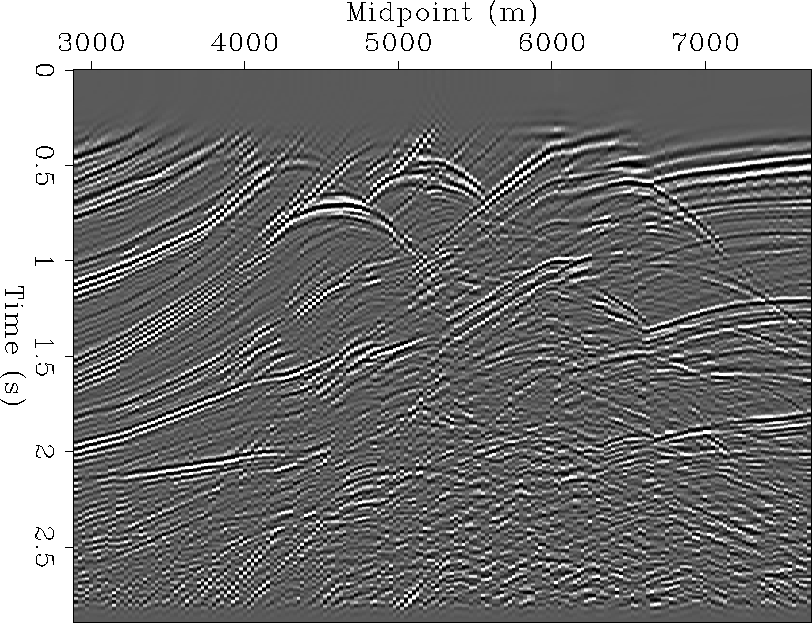 |
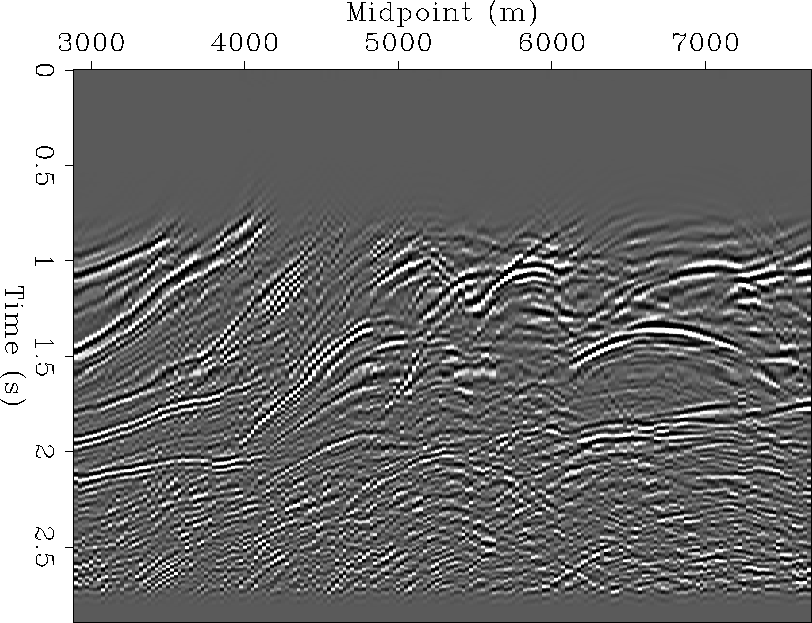 |
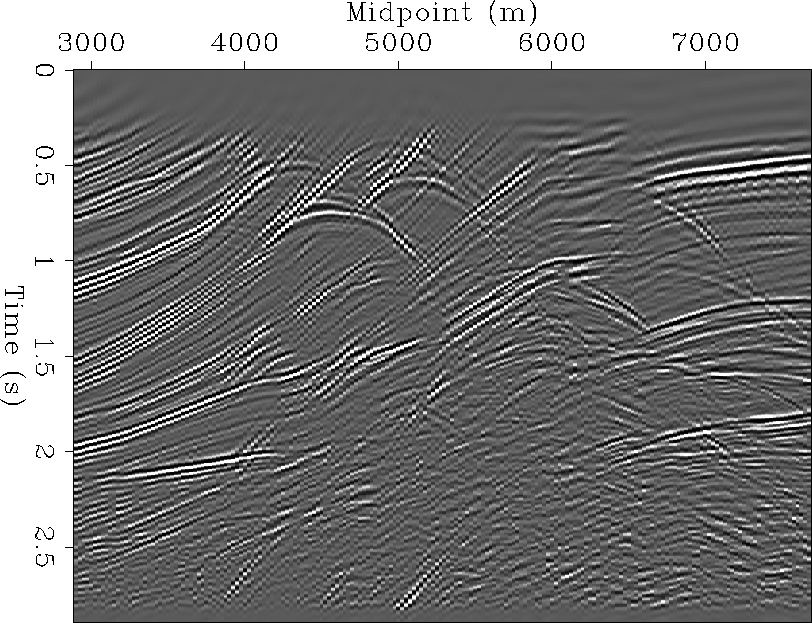 |
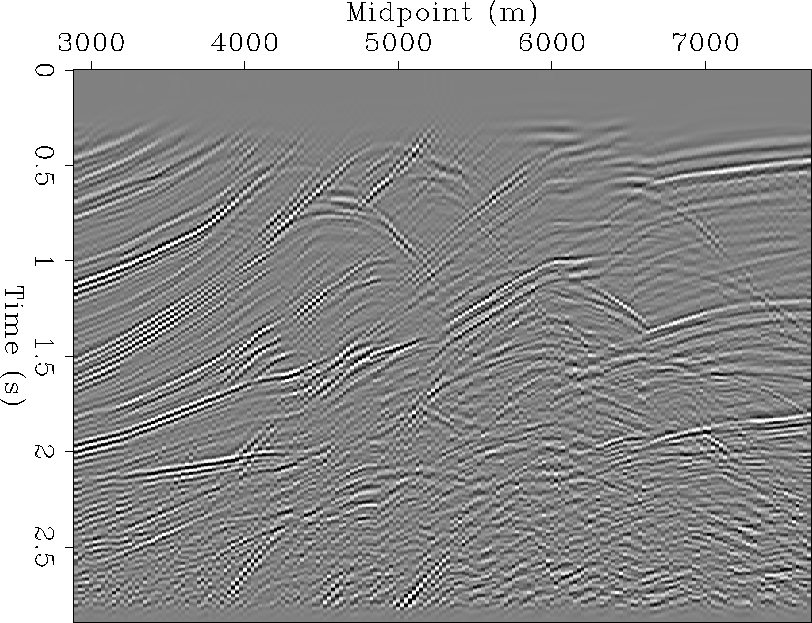 |
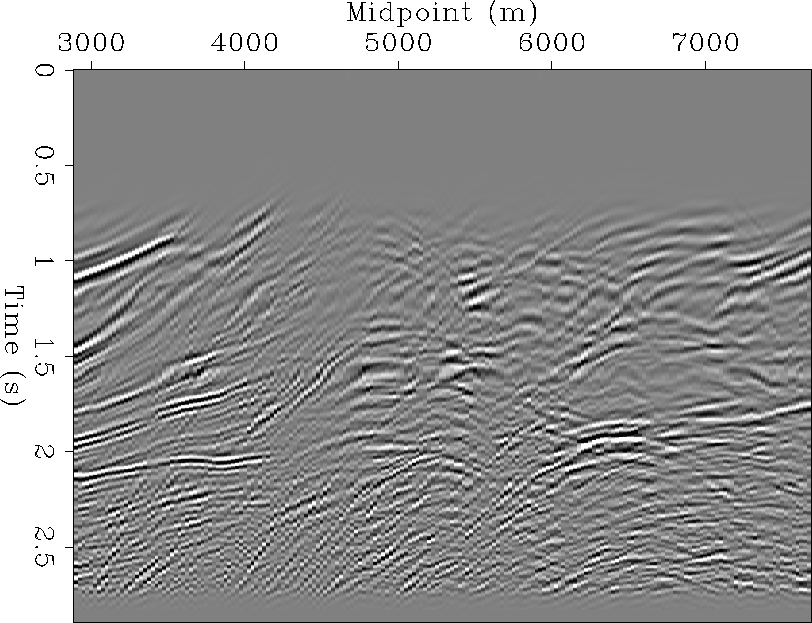 |
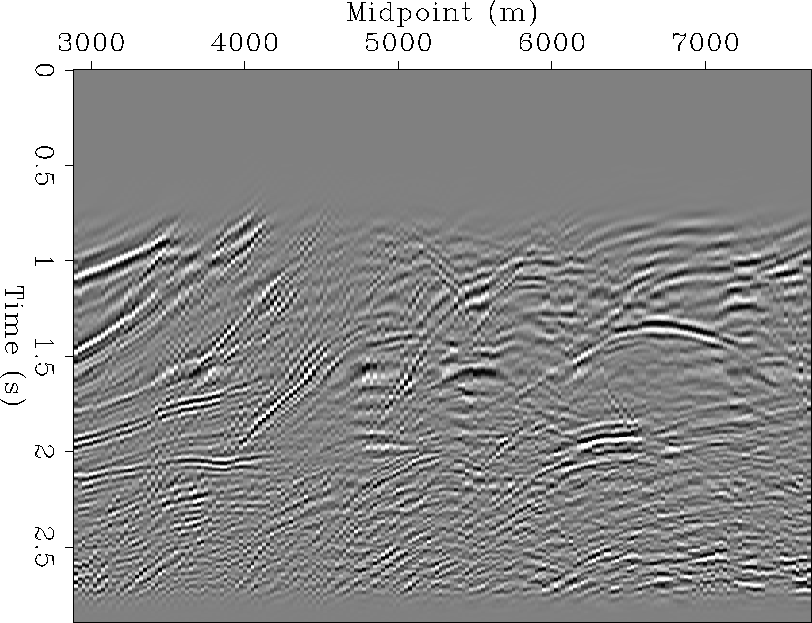 |
We also noticed that some curved events present in the original sections (i.e., around CDP location 4500m on the near-offset section and 6700m on the far-offset section in Figure offset-900) were filtered by the AMO and stacking process. We think that these arrivals do not represent primary reflections but are either prism waves and head waves traveling along the grabens. These events would not be well focused by conventional migration techniques.
Overall, the AMO process on the synthetic Marmousi data reduced its size by about an order of magnitude while preserving the quality of the data and the complex geology. On a real data example, we expect AMO transformation to produce high lateral resolution because of coherent stacking of reflections with all slopes and substantial attenuation of noise level.
CONCLUSIONS
We have applied a new operator for offset continuation on the 2-D Marmousi data set. We successfully reduced the size of the data by coherent partial stacking of traces with similar offset. The AMO transformation to a common offset eliminates the dip filtering action of CMP stacking by preserving the dipping reflections and diffractions.
We applied the AMO process as an integral operator in the time-space domain. For small offset continuations, the operator is very compact and inexpensive to apply. It also requires special care to avoid aliasing.
[SEP,paper]
![[*]](http://sepwww.stanford.edu/latex2html/prev_gr.gif)